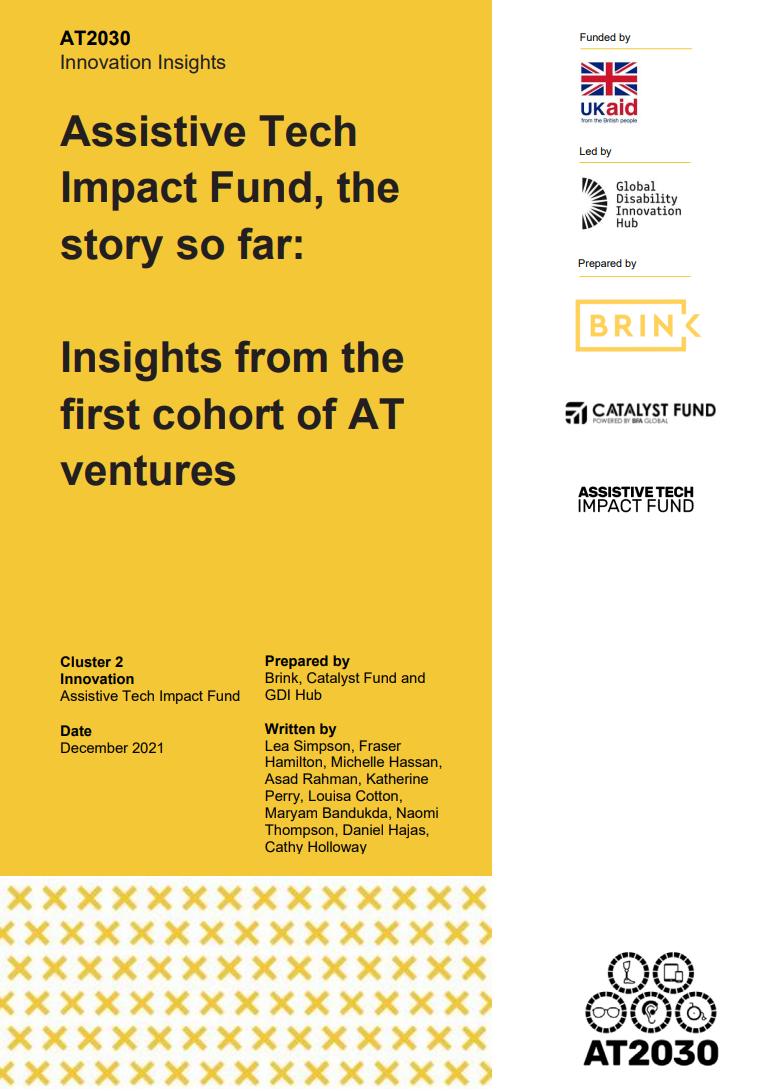Publications
-
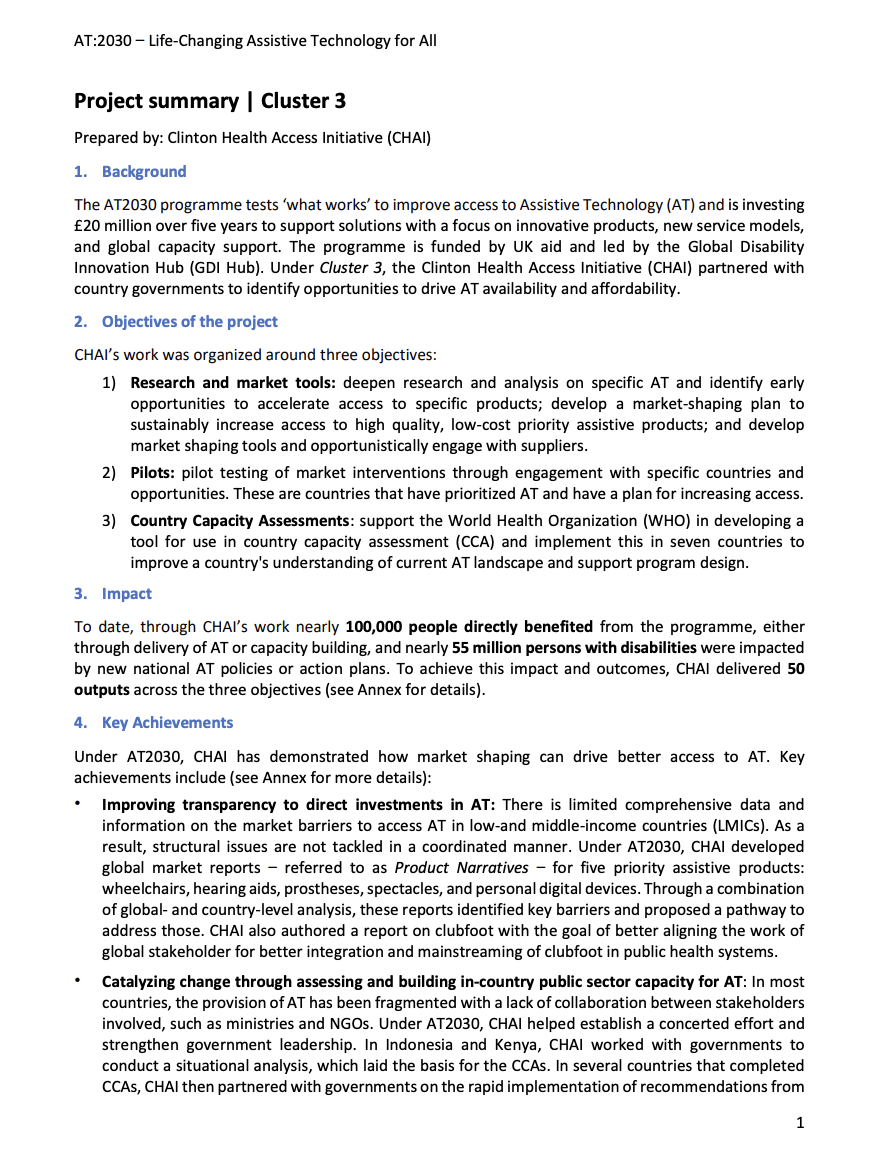
Project Summary: Drive Affordability and Availability
Clinton Health Access InitiativeMarch 10, 2022GlobalCase Studies and ReportsProject Summary of Sub-Programme 6: Drive Affordability and Availability, under Cluster 3. The Clinton Health Access Initiative (CHAI) partnered with country governments to identify opportunities to drive AT availability and affordability. This summary document highlights objectives of the project, impact, key achievements, lessons learned and outputs.
-
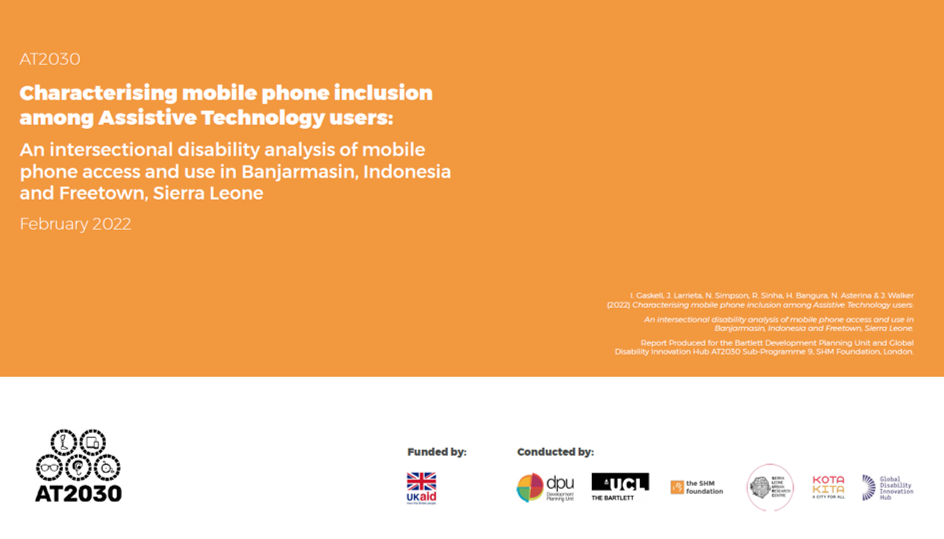
Characterising mobile phone inclusion among Assistive Technology users
Global Disability Innovation Hub, Kota Kita, Development Planning Unit (DPU), SLURC, the SHM foundationMarch 10, 2022Sierra Leone, IndonesiaCase Studies and ReportsCharacterising mobile phone inclusion among Assistive Technology users: An intersectional disability analysis of mobile phone access and use in Banjarmasin, Indonesia and Freetown, Sierra Leone This report shares the findings of research conducted in five informal settlements across the cities of Banjarmasin, Indonesia and Freetown, Sierra Leone, in 2020- 2021 as part of the AT2030 Project (AT2030 SP9).
-
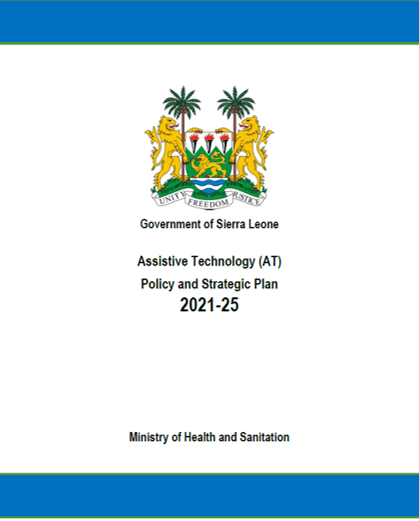
Assistive Technology (AT) Policy and Strategic Plan 2021-25
Clinton Health Access Initiative, Government of Sierra LeoneFeb. 24, 2022Sierra LeoneAT2030 ResourcesThe Assistive Technology Policy and Strategic Plan was developed by the Clinton Health Access Initiative under the AT2030 Programme Country Investment Fund.
-
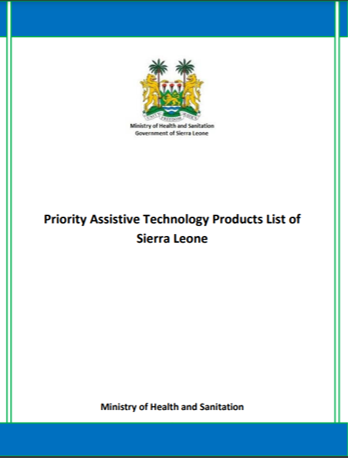
Priority Assistive Technology Products List of Sierra Leone
Clinton Health Access InitiativeFeb. 24, 2022Sierra LeoneAT2030 ResourcesThe Priority Assistive Technology Products List of Sierra Leone Report was developed by the Clinton Health Access Initiative under the AT2030 programme's Country Investment Fund.
-
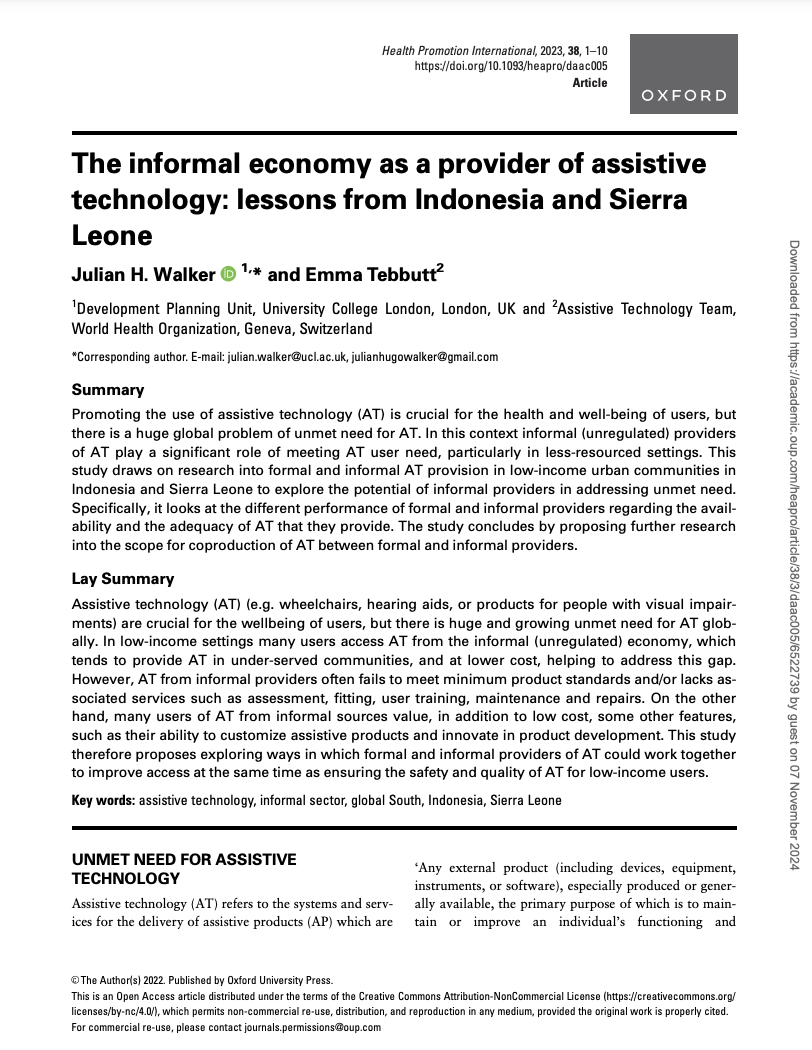
The informal economy as a provider of assistive technology: lessons from Indonesia and Sierra Leone
Emma Tebbutt, Julian WalkerFeb. 4, 2022Sierra Leone, IndonesiaAcademic Research PublicationsAssistive technology (AT) (e.g. wheelchairs, hearing aids, or products for people with visual impairments) are crucial for the wellbeing of users, but there is huge and growing unmet need for AT globally. In low-income settings many users access AT from the informal (unregulated) economy, which tends to provide AT in under-served communities, and at lower cost, helping to address this gap. However, AT from informal providers often fails to meet minimum product standards and/or lacks associated services such as assessment, fitting, user training, maintenance and repairs. On the other hand, many users of AT from informal sources value, in addition to low cost, some other features, such as their ability to customize assistive products and innovate in product development. This study therefore proposes exploring ways in which formal and informal providers of AT could work together to improve access at the same time as ensuring the safety and quality of AT for low-income users.
-
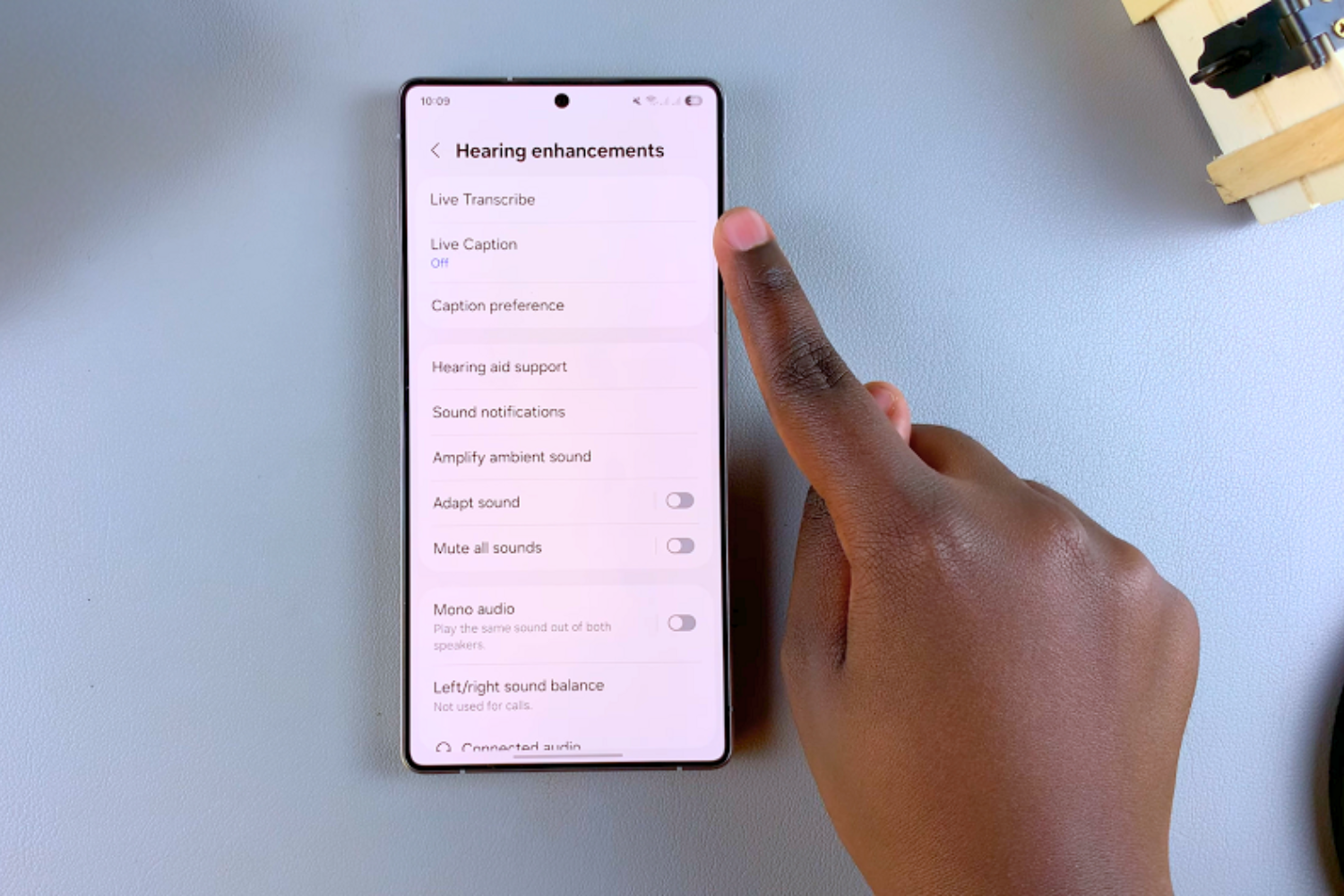
HearX publication: Hearing care by community health workers using digital technologies
hearX, Caitlin Frisby, Tersia de Kock, De Wet SwanepoelFeb. 4, 2022KenyaCase Studies and ReportsA brilliant new report by hearX published in ENT UK Global Health showcasing innovative digital technologies and service solutions to meet the unmet need of hearing loss.
-
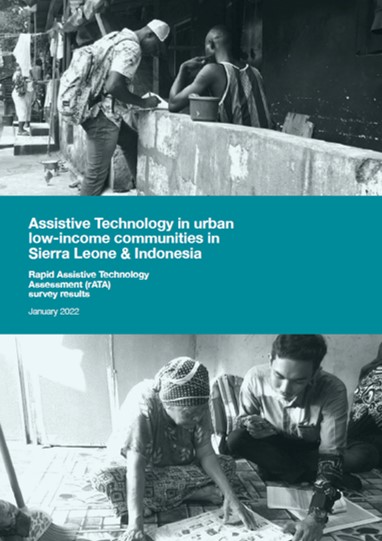
Assistive Technology in urban low-income communities in Sierra Leone & Indonesia
Global Disability Innovation Hub, Dr Mark Carew, Development Planning Unit (DPU), Julian Walker, Dr Ignacia Ossul VermehrenJan. 21, 2022Sierra Leone, IndonesiaAT2030 ResourcesA new report presenting the findings from surveys in five urban low-income communities in Sierra Leone and Indonesia using the rapid Assistive Technology Assessment (rATA) tool.
-
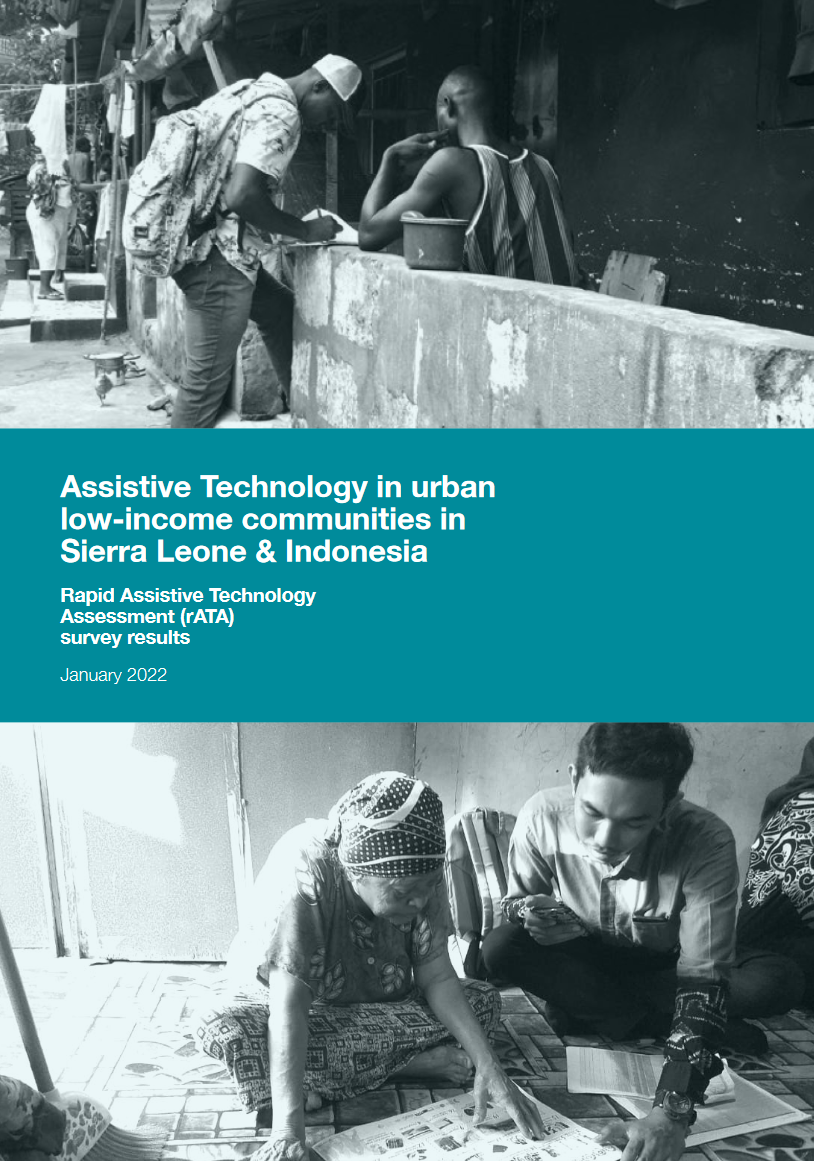
Assistive Technology in urban low-income communities in Sierra Leone and Indonesia: Rapid Assistive Technology Assessment (rATA) survey results
Development Planning Unit (DPU)Jan. 12, 2022Case Studies and ReportsThe findings from the surveys presented in this report give a unique insight into disability prevalence and access to AT in five urban low-income communities in Sierra Leone and Indonesia.
-

Meeting AT needs in humanitarian crises: The current state of provision
Dr Maria Kett, Golnaz Whittaker, Gavin Adam Wood, Giulia Oggero, Kirstin LangeDec. 24, 2021Academic Research PublicationsThis paper discusses the evidence available in the literature for the scale and quality of AT provision interventions in crises, and what is known about the challenges and facilitators of provision. We conducted a search of the academic literature and retained literature that reported on any form of AT provision following crisis, where international humanitarian response was in place, published in English between January 2010 and June 2020. We conclude by providing recommendations for urgent actions that the AT and humanitarian community must take to fill this critical gap in the provision of essential products and services for a potentially marginalized and excluded group.
-
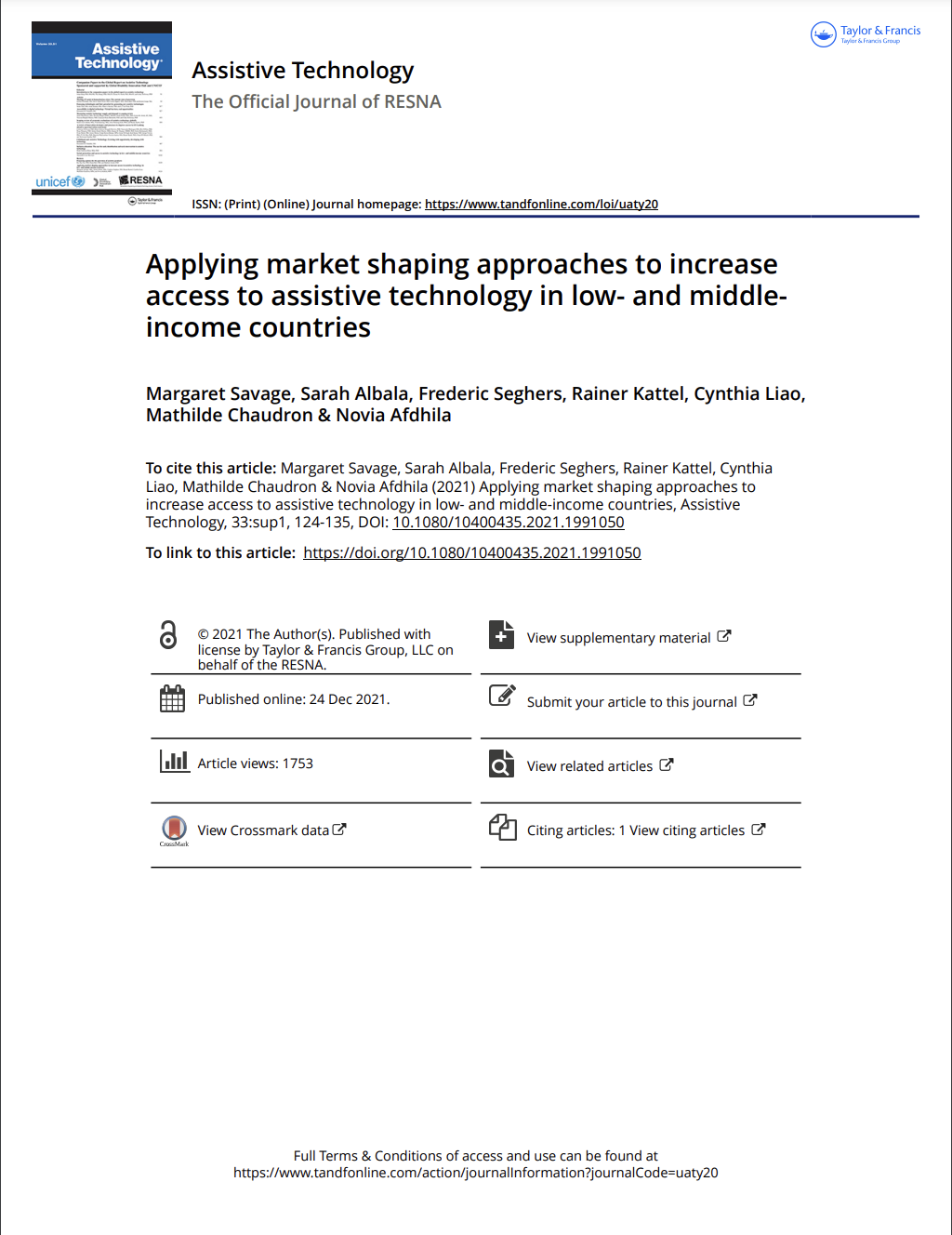
Applying market shaping approaches to increase access to assistive technology in low- and middle-income countries
Sarah Albala, Rainer Kattel, Frederic Seghers, Novia Afdhila, Margaret Savage, Cynthia Liao, Mathilde ChaudronDec. 24, 2021Academic Research PublicationsMarket shaping is aimed at improving a market’s specific outcomes, such as access to high quality, affordable AT, by targeting the root causes of these shortcomings. The paper summarizes the findings of market analyses conducted under the UK aid funded AT2030 programme in support of ATscale and aims to discuss how market shaping can help more people gain access to the AT that they need and what are the best mechanisms to unlock markets and commercial opportunity in LMICs.
-
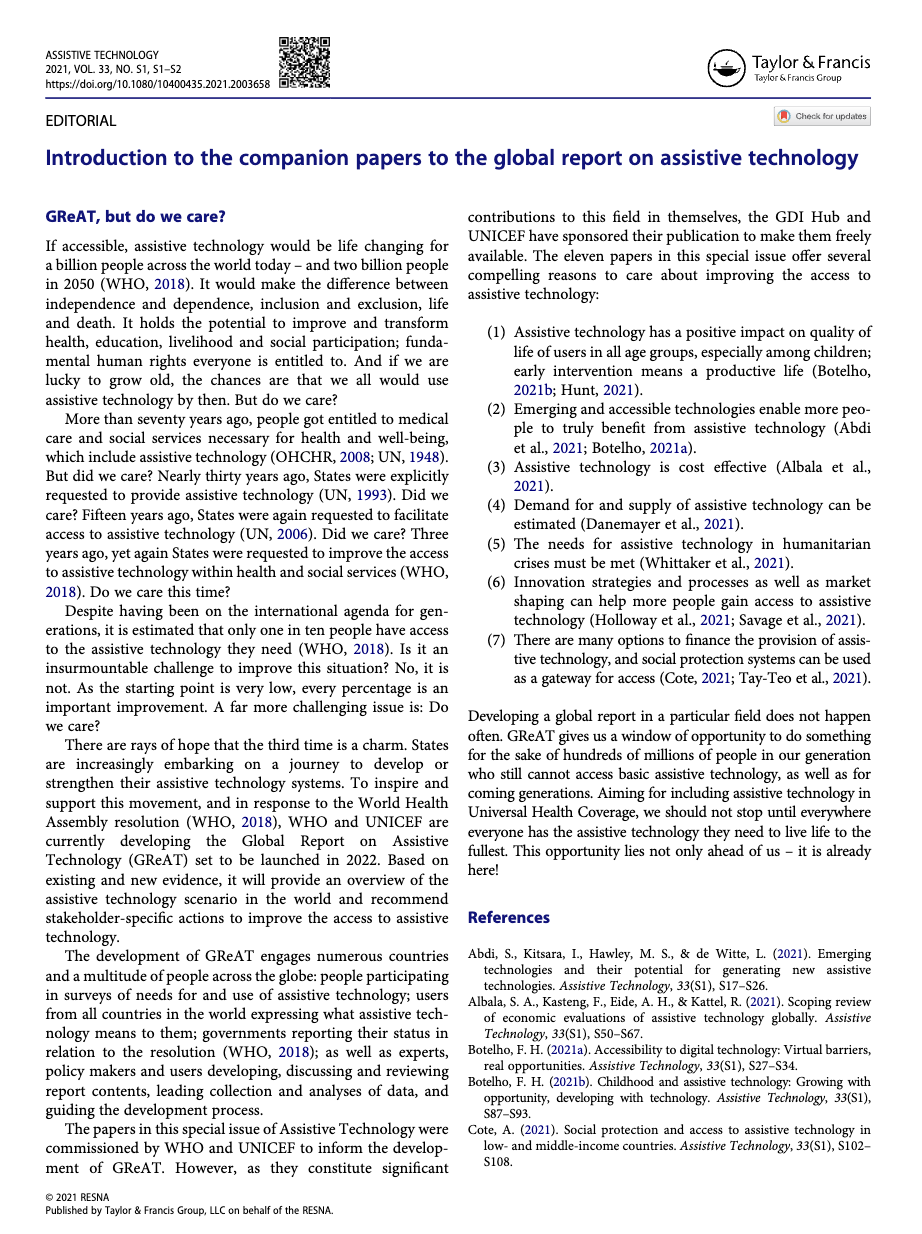
Introduction to the companion papers to the global report on assistive technology
Catherine Holloway, Wei Zhang, Johan Borg, Emma M. SmithDec. 24, 2021Academic Research PublicationsAn introduction to the companion papers to the Global Report on Assistive Technology (GReAT).
-
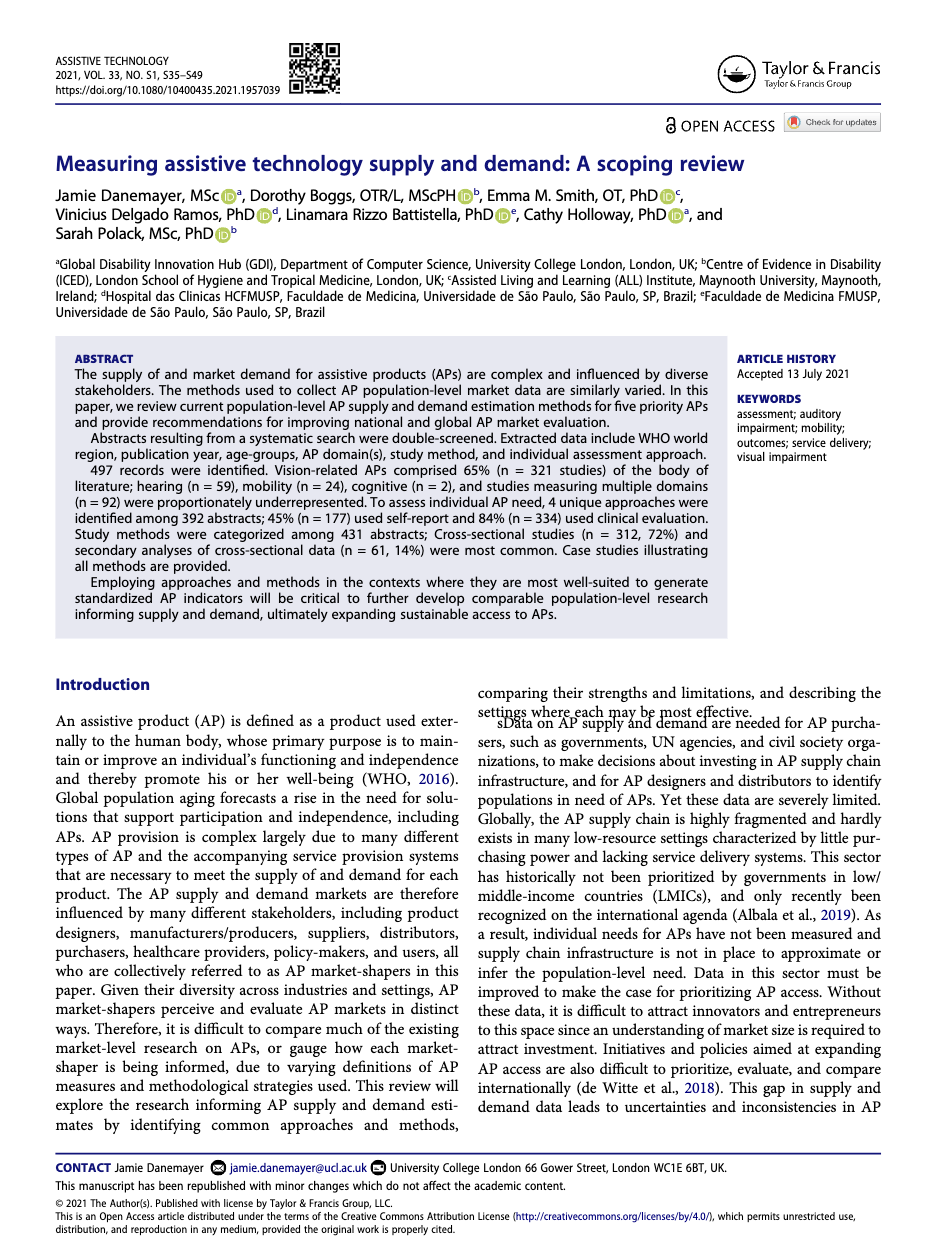
Measuring assistive technology supply and demand: A scoping review
Catherine Holloway, Jamie Danemayer, Dorothy Boggs, Emma M. Smith, Vinicius Delgado Ramos, Linamara Rizzo BattistellaDec. 24, 2021Academic Research PublicationsThe supply of and market demand for assistive products (APs) are complex and influenced by diverse stakeholders. The methods used to collect AP population-level market data are similarly varied. In this paper, we review current population-level AP supply and demand estimation methods for five priority APs and provide recommendations for improving national and global AP market evaluation.
-
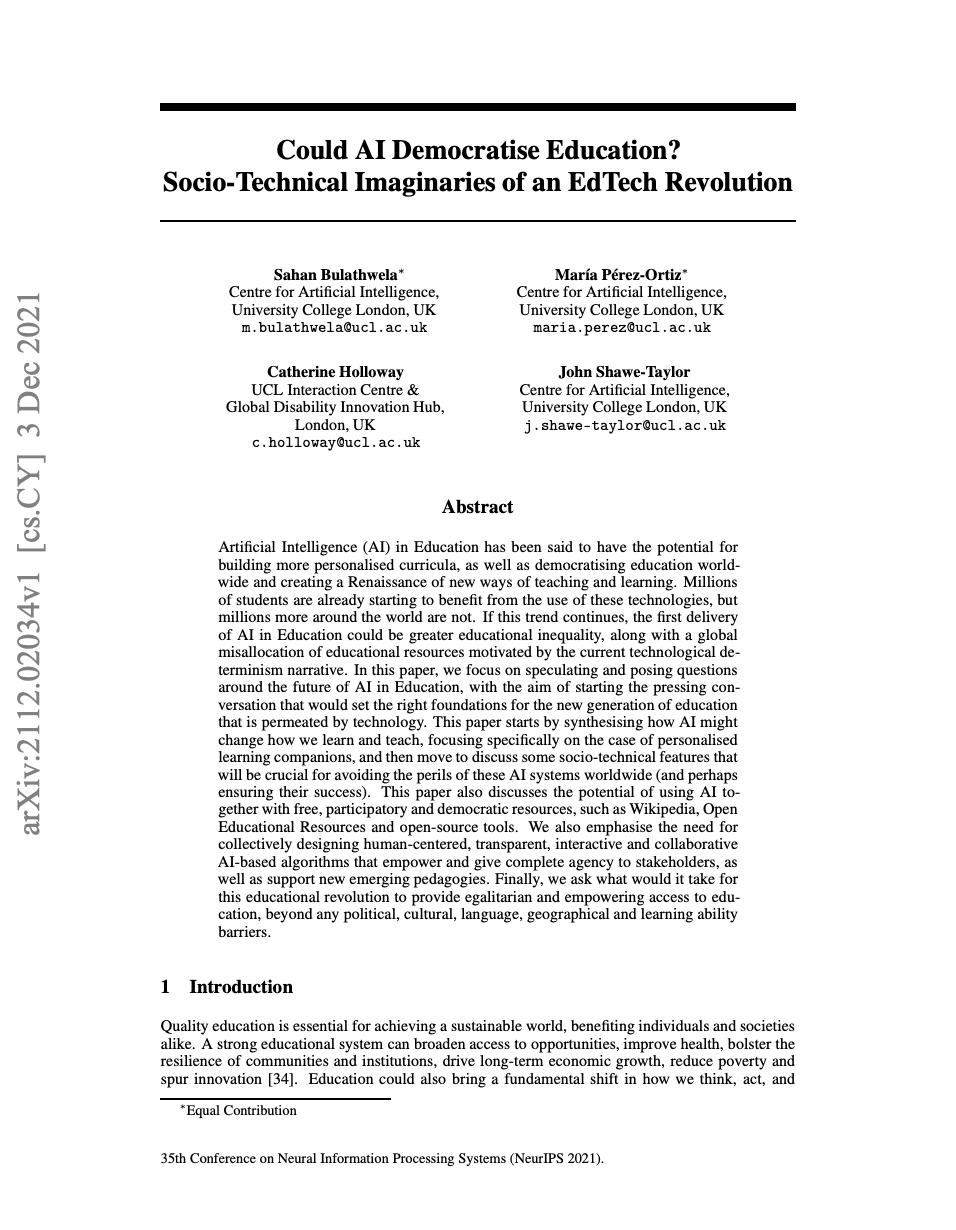
Could AI Democratise Education? Socio-Technical Imaginaries of an EdTech Revolution
Catherine Holloway, Sahan Bulathwela, María Pérez-Ortiz, John Shawe-TaylorDec. 3, 2021Academic Research PublicationsArtificial Intelligence (AI) in Education has been said to have the potential for building more personalised curricula, as well as democratising education worldwide and creating a Renaissance of new ways of teaching and learning. Millions of students are already starting to benefit from the use of these technologies, but millions more around the world are not. This paper starts by synthesising how AI might change how we learn and teach, focusing specifically on the case of personalised learning companions, and then move to discuss some socio-technical features that will be crucial for avoiding the perils of these AI systems worldwide (and perhaps ensuring their success).
-
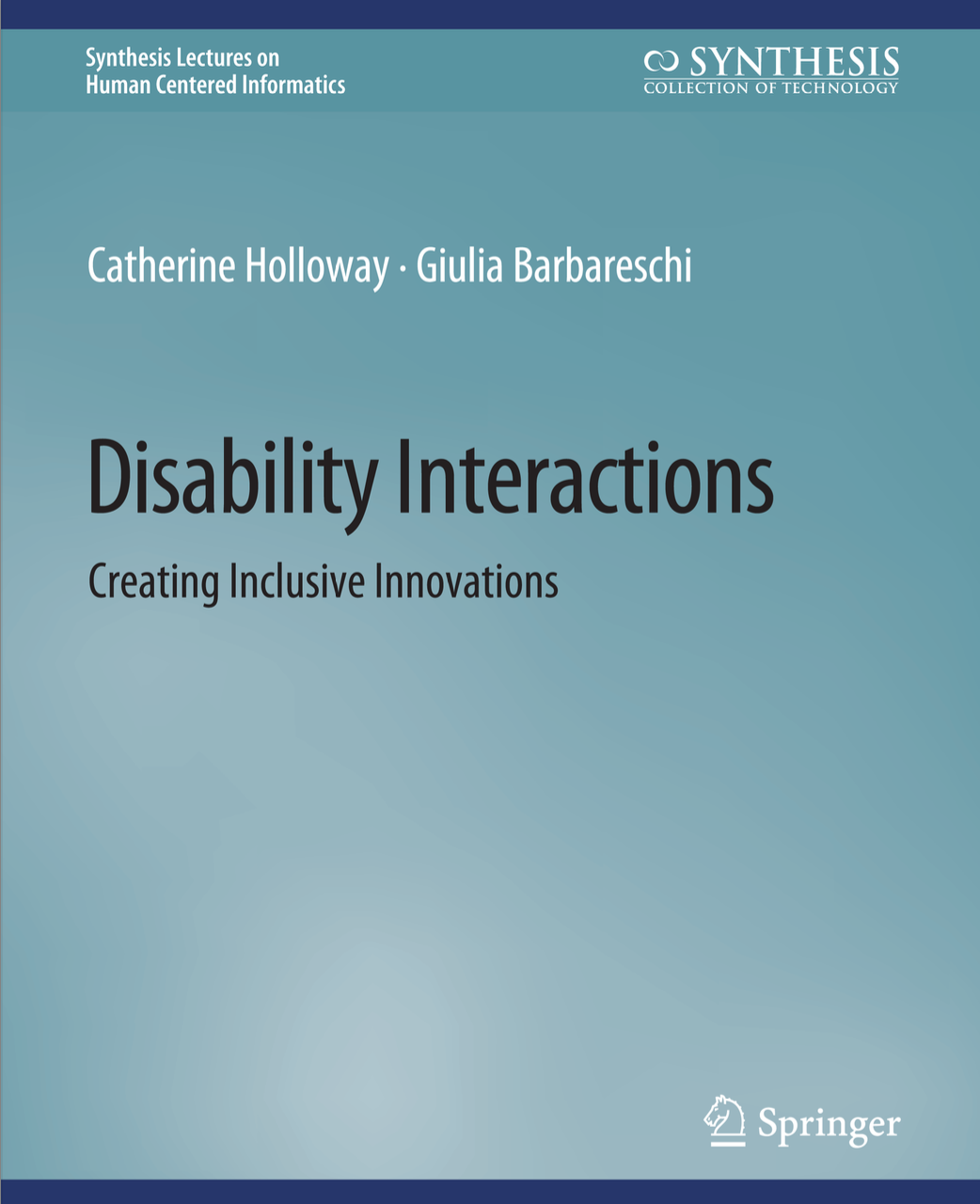
Disability Interactions Creating Inclusive Innovations
Catherine Holloway, Giulia BarbareschiDec. 1, 2021Academic Research PublicationsDisability interactions (DIX) is a new approach to combining cross-disciplinary methods and theories from Human Computer Interaction (HCI), disability studies, assistive technology, and social development to co-create new technologies, experiences, and ways of working with disabled people.
-
Assistive Tech Impact Fund the story so far
Global Disability Innovation Hub, Brink, Catalyst FundDec. 1, 2021Case Studies and ReportsThis paper presents key insights from our work with the first cohort of AT ventures who are pushing the boundaries of AT innovation and disrupting the archaic models of AT production and supply in the African market. The Assistive Tech Impact Fund (ATIF), provides grant funding as well as bespoke business, research, and technical support to pioneering Assistive Tech innovators working towards increasing AT access to millions of AT users across Africa.
-
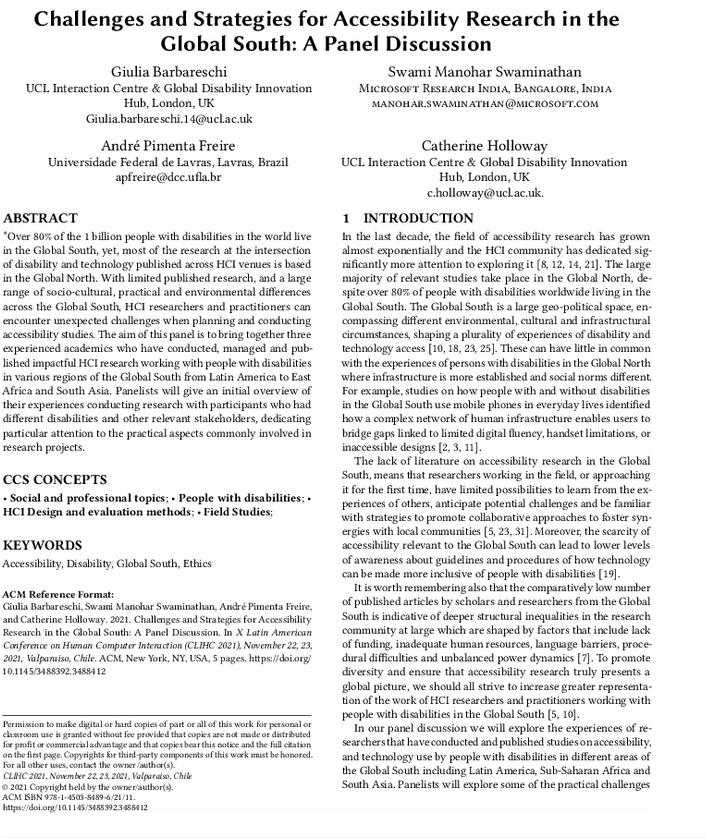
Challenges and Strategies for Accessibility Research in the Global South: A Panel Discussion
Catherine Holloway, Giulia Barbareschi, Manohar Swaminathan, Andre Pimenta FreireNov. 22, 2021Academic Research PublicationsOver 80% of the 1 billion people with disabilities live in the Global South, yet most HCI research on disability and technology is from the Global North. This lack of research, along with diverse socio-cultural factors, creates challenges for accessibility studies in the Global South. This panel features three experienced academics who will share their insights from conducting impactful HCI research with disabled individuals across regions like Latin America, East Africa, and South Asia, focusing on practical aspects of engaging participants and stakeholders.
-
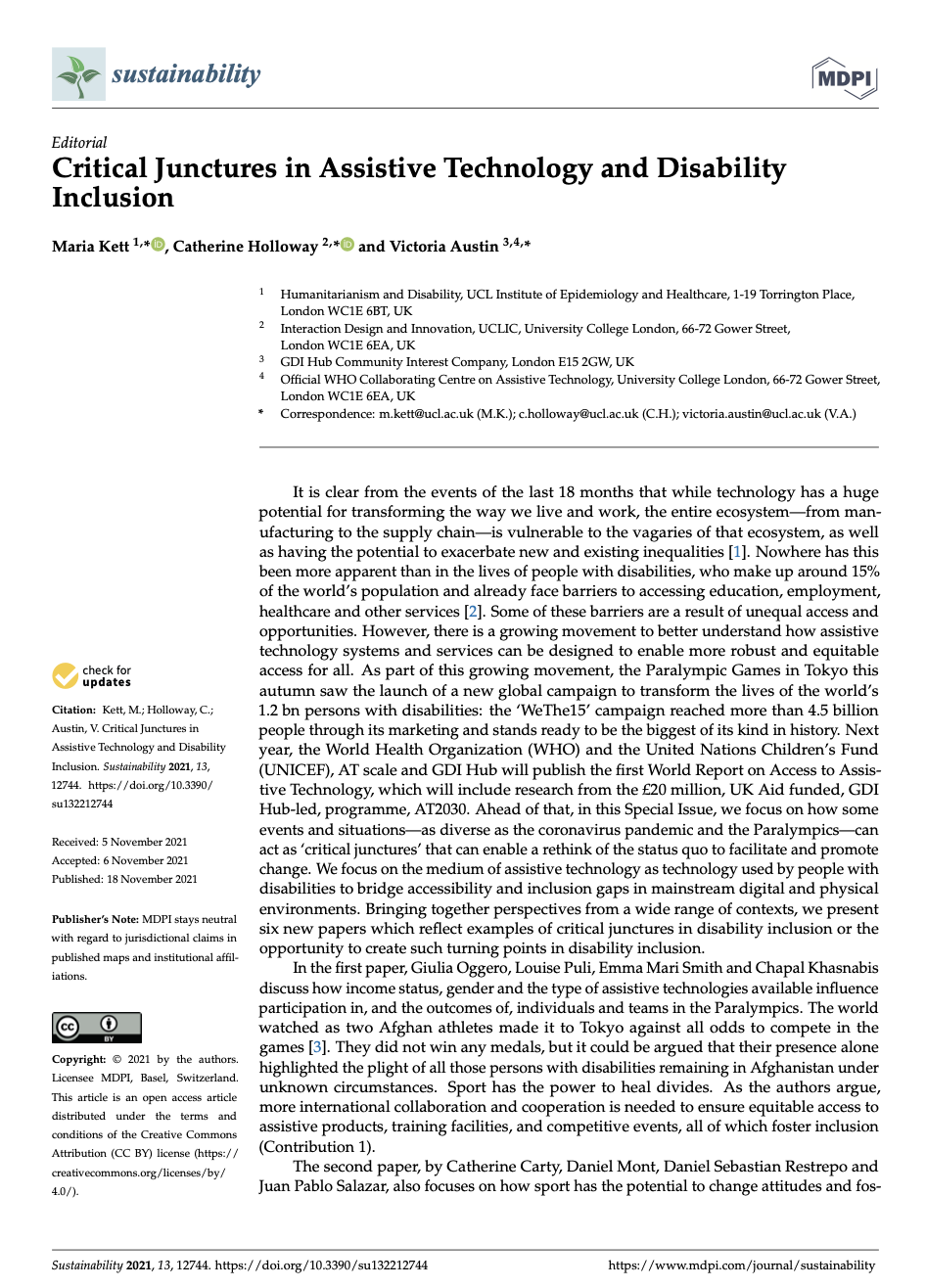
Critical Junctures in Assistive Technology and Disability Inclusion
Catherine Holloway, Vicki Austin, Dr Maria KettNov. 5, 2021Academic Research PublicationsA commentary written by Maria Kett, Catherine Holloway and Vicki Austin in a Special Issue of Sustainability that focuses on how some events and situations can act as ‘critical junctures’ that can enable a rethink of the status quo to facilitate and promote change and turning points in disability inclusion.
-
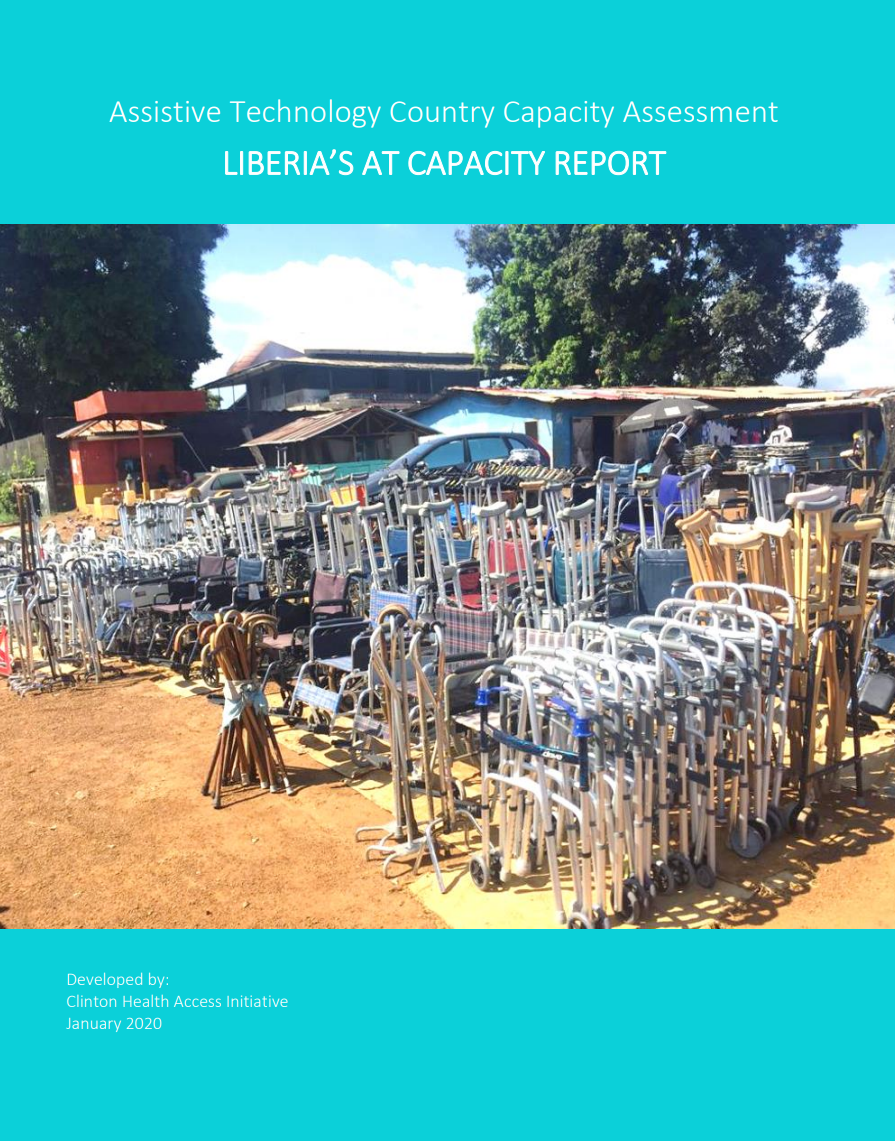
Liberia Country Capacity Assessment
Clinton Health Access InitiativeNov. 2, 2021LiberiaCase Studies and ReportsLiberia has a disability prevalence of 3.17%. Of the disabled population, the majority experience visual impairments (34%), followed by mobility impairments (25%), hearing impairments (11%), communication impairments (4%), and cognitive impairments (4%). This Assistive Technology Country Capacity Assessment looks to understand the country’s current systems capacity to provide AT. The findings are intended to increase awareness and knowledge of AT among partners; and to identify gaps that would benefit from increased and coordinated investments.
-
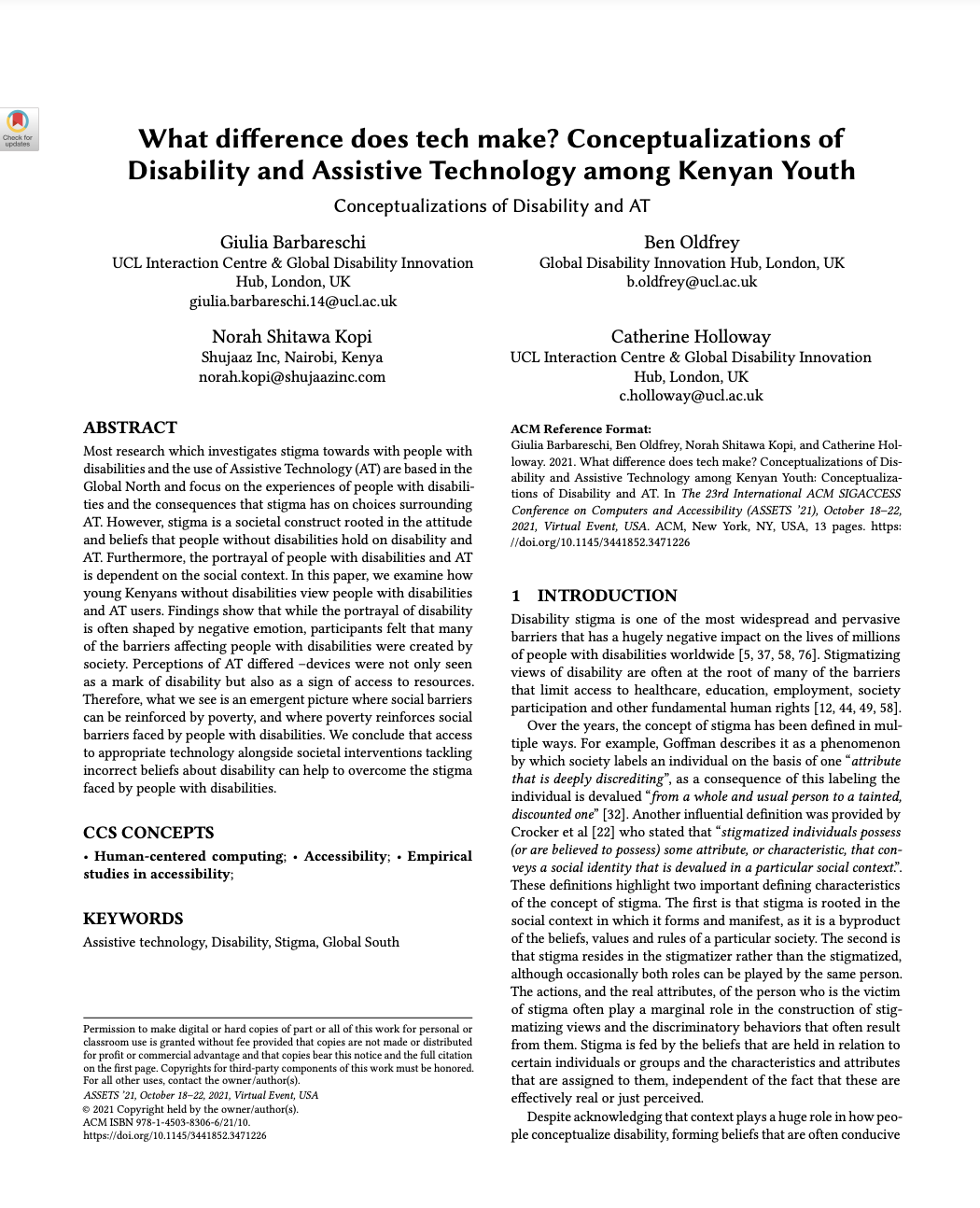
What difference does tech make? Conceptualizations of Disability and Assistive Technology among Kenyan Youth: Conceptualizations of Disability and AT
Catherine Holloway, Giulia Barbareschi, Dr Ben Oldfrey, Norah KopiOct. 31, 2021KenyaAcademic Research PublicationsThis research article examines how young Kenyans without disabilities view people with disabilities and AT users.
-
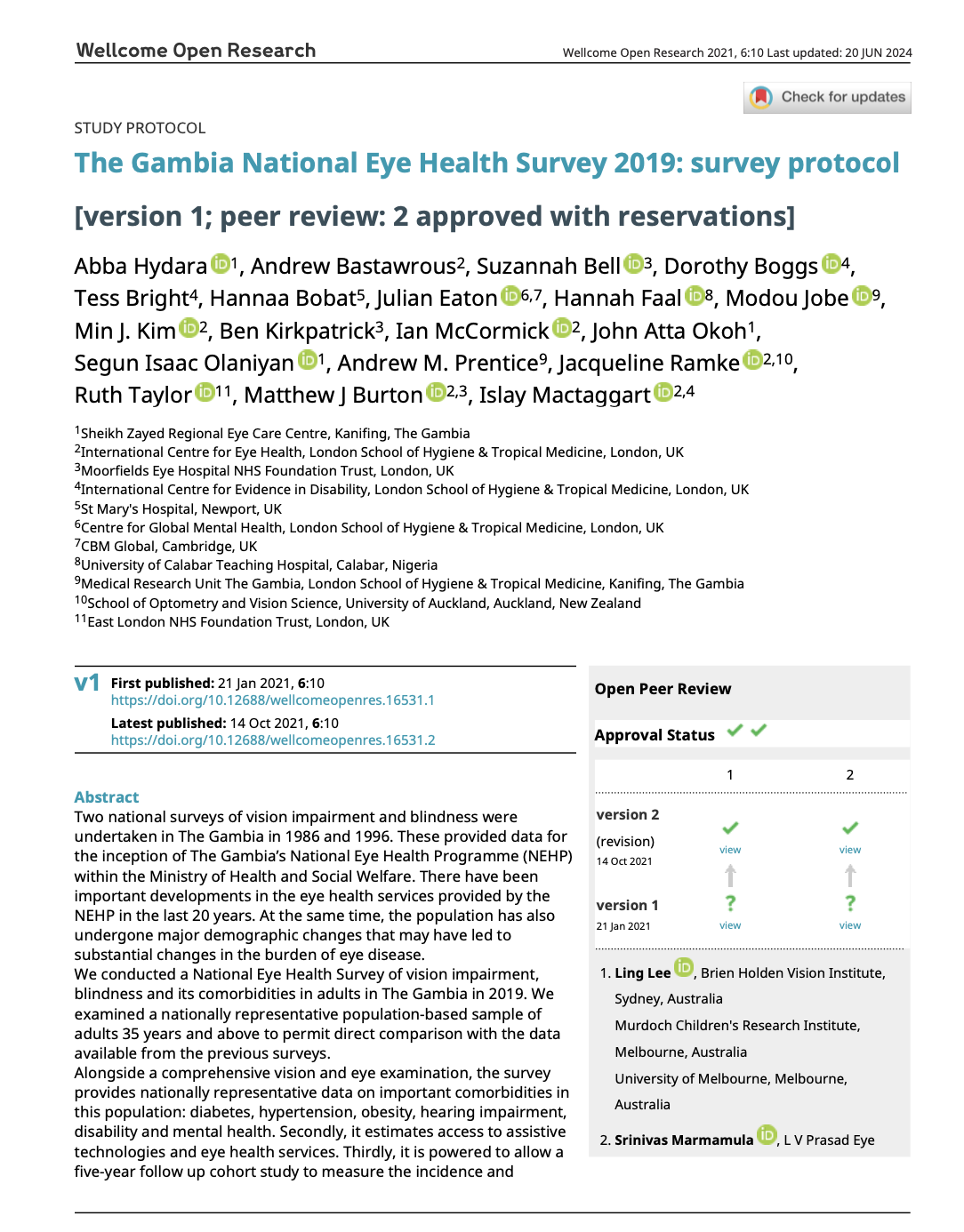
The Gambia National Eye Health Survey 2019: survey protocol
Abba Hydara, Dorothy Boggs, John A. Okah, Segun I. Olaniyan, Ian McCormick, Tess Bright, Suzannah Bell, Andrew Bastawrous, Hannaa Bobat, Julian Eaton, Hannah Faal, Modou Jobe, Min J. Kim, Ben Kirkpatrick, Andrew M. Prentice, Jacqueline Ramke, Islay Mactaggart, Matthew J. Burton, Ruth TaylorOct. 14, 2021GambiaAcademic Research PublicationsSurvey protocol of a National Eye Health Survey of vision impairment, blindness and its comorbidities in adults in The Gambia in 2019.
Previous PageNext Page
